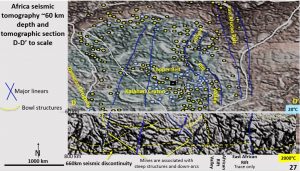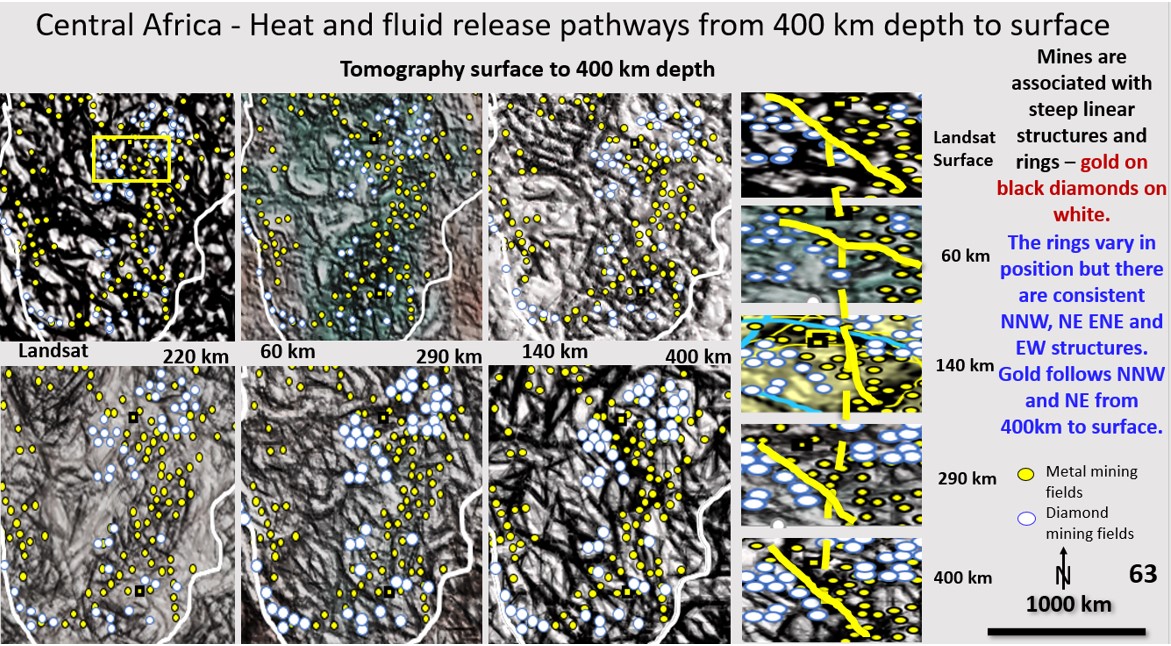The African Webinar can be viewed at https://vimeo.com/464013825/1ed4a0c752 . Start at about 5 minutes to get straight into it.
Figure 63 (above). African Landsat and ultra-detailed Seismic Tomography from 60 – 400 km depth with mines overlaid. Mineralisation pathway on right hand side.
The above image shows, in sequence, the Landsat surface and the seismic tomography from 60 km to 400 km depth. One thing that does stand out is the close similarity of the Landsat pattern of mines and structures with the 400 km deep structural geology.
The right-hand side image is an attempt to show how the mineralising fluids work their way from the 400 km deep level to the surface. They followed any dark (structurally complex) area irrespective of its direction at any particular level. It is interesting that the diamond mines lie on the light cratonic areas all the way up. This shows that the cratonic areas are consistent vertically.
This implies that the huge impacts that formed the original cratonic areas were not smashed up by later impacts, or swept away by the mantle, but were just built upon. This suggests the earth was solid and unmoving at >400 kms depth at the start of the Late Heavy Bombardment at 4.1 billion years ago and has remained like that under Africa.
If Africa has been one supercontinent since the LHB (3.8 billion years ago) then it is reasonable to suggest the other major continents are also. My research in Australia, Antarctica, South America, China, Russia and North America confirms this hypothesis.
The main mining fields in Africa are located on the ring structures and linears from the surface right to the limits of detailed data at 400 km depth. The mechanism and source of the fluid for most mineralisation may have been discovered by this research.
The source is suggested to be from passive resorption of the Lithosphere by heat from as far down as the core. This fluid then follows vertical structures to the surface scavenging and depositing minerals aqs it ascends. I have defined these structures down to 800 km depth in cross section (see figure below).

This cross section cuts across south of the Zambia Copper Belt and north of Johannesburg. The East African Rift can be seen to extend right to the bottom of the section however it is only a series of faults this far south.
The fluid pathways for the mines (vertical yellow dashed lines) are clearly seen on the section under both the Copper Belt and over and to the west. They extend the full depth of the section. They are quite different to the orthogonal brittle structures on the section. The bowl-shaped structures (yellow dashed arcs) correlate well with the Kalahari Craton ring structure. That hydrothermal activity is associated with more recent surface impacts was documented by Pirajno in 2005
According to the current Plate Tectonics hypothesis Africa formed by a series of accretions to this original Congo Craton (Linol et al, 2014, Bercovici et al, 2015). However, this section shows unbroken bowl-shaped structures and cratonic material over the entire African supercontinent, therefore African accretion cannot have not occurred – except at the surface in the crust.
Does this plan and sectional view of Africa correlate with other areas of Earth?
My research shows that this mechanism also occurs in Australia, North and South America, China and Fennoscandia. This suggests a close connection between deeply buried LHB impact structures, world-girdling linears and mineralisation. Once this relationship has been firmly established, and acted upon for mineral and energy targeting, a giant leap forward will have been made in exploration understanding and success.
If you find these posts useful share them with your colleagues —

